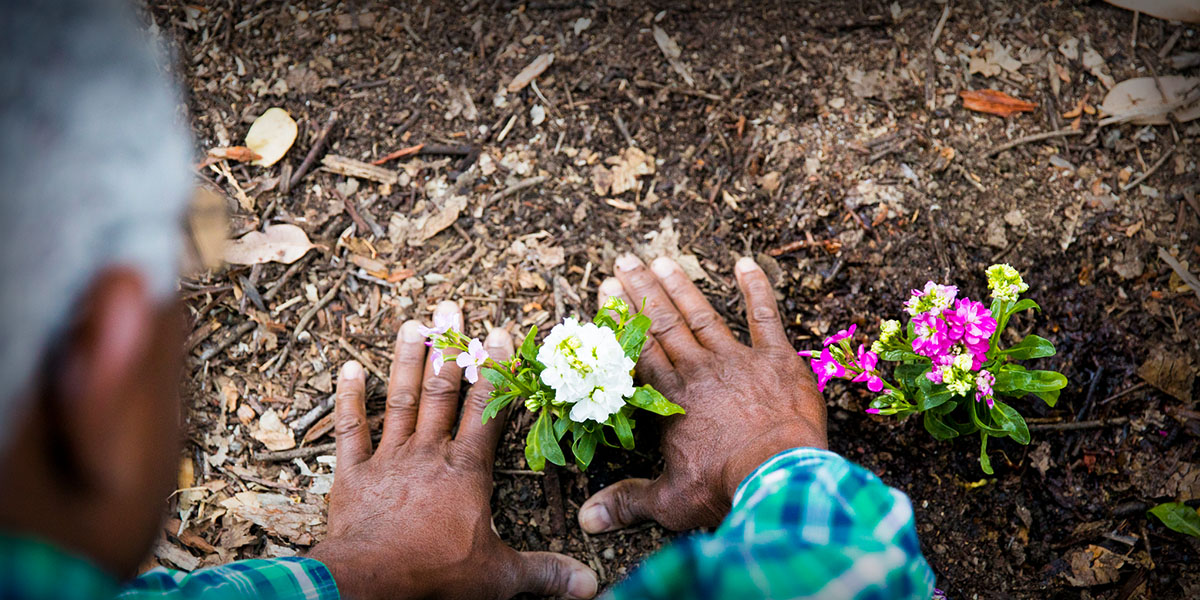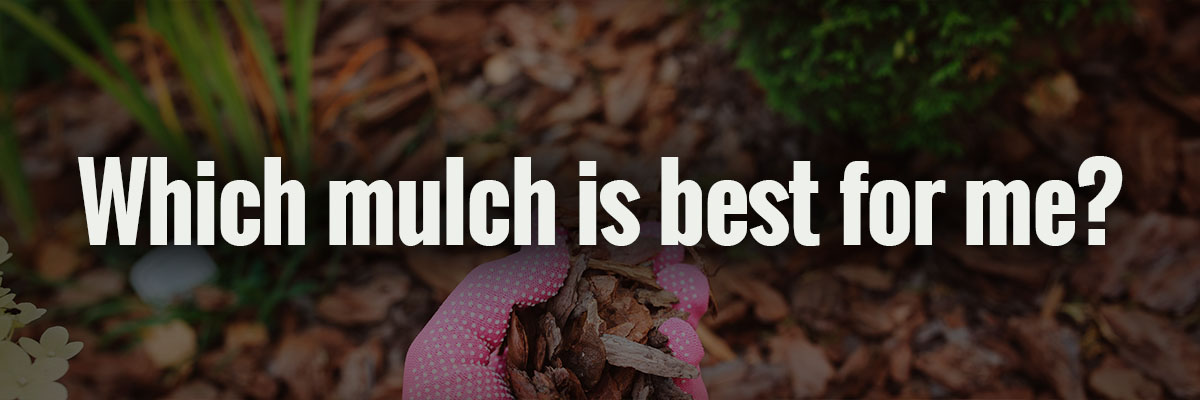How to Choose the Best Mulch
August 26, 2020

With the rainy season just months away, now is a great time to take advantage of the many benefits of mulch and improve your garden or landscape at the same time!
What is mulch?
Mulch is any material spread to cover and protect soil and surrounding plants. Mulch often consists of chipped or shredded vegetation or bark, but can also be made from rock, cocoa beans, straw, or even artificial materials like rubber or landscape fabric. In addition to beautifying your landscape, mulch contributes to a healthier garden and cleaner waterways. Keep reading to learn which mulch is best for you and how proper mulching can improve the quality of our creeks, rivers, and ocean.
Why does mulch matter?
Mulch has many benefits that help protect and enhance your soil and garden, keeping both you and your garden happy. Not only does mulch reduce your garden maintenance, it also retains moisture and keeps your plants cool and happy – especially important during hot summer days!
- Conserves Water – Mulch absorbs water and reduces the amount of water that evaporates from soil, reducing the need to water plants.
- Moderates Soil Temperature – Mulch regulates moisture and soil temperature forming a “thermal jacket” that keeps soil warm on cold nights and cool on hot days, which insulates plant roots from temperature changes.
- Improves Soil Quality and Reduces Erosion – Mulch improves the quality of soil by allowing better water and air movement and aiding in nutrient decomposition; it also acts as a protective covering that helps prevent soil erosion from wind, rain, and irrigation.
- Prevents Runoff Pollution – Mulch keeps rain and irrigation on site, preventing excess water from running off and polluting our waterways. Instead, this water either soaks into the soil or evaporates.
Learn more about the impact of mulches on landscape plants in this brochure from the University of California Cooperative Extension.

In addition to the benefits above, some mulches are also able to absorb water. There are two main types of mulch: organic and inorganic.
Organic mulches are better at absorbing water. Common organic mulches include grass clippings, greenwaste, leaves, straw, hay, bark, and wood. Organic mulch can act as a giant sponge by absorbing and holding excess water, then slowly releasing water into the soil or air. Using organic mulch not only helps reduce the need to water, but also prevents the growth of weeds, reducing the need for pesticides. By choosing organic mulch, you can help conserve water, beautify your landscape and prevent polluted runoff from flowing untreated into our local waterways and ocean.
Inorganic mulches include gravel, rubber, geotextile mats, landscape fabrics, and plastic. Some inorganic mulches like stone, rock or gravel do not absorb water but provide benefits such as air and water movement, weed control and prevent loss of soil moisture through evaporation. Synthetic mulches like black plastic generally are not intended to absorb water and may actually inhibit the ability of water to reach the soil.
Learn more about the variety of mulches available and their different qualities, benefits and drawbacks from the University of California Agricultural and Natural Resources publication.

The best mulch for your landscape depends on the type of garden area you wish to mulch and your personal aesthetic preferences.
- Vegetable Gardens and Annual Flowerbeds – In areas where the ground will be worked every year, straw, hay or compost may be ideal, as they can be incorporated into the soil if desired.
- Perennial Beds or Foundation Plantings – Long-lasting materials such as bark mulches are best for use around trees, shrubs and perennial beds where a slow release of nutrients over time is desired. Bark mulch is also appropriate for areas where you won’t be doing a lot of digging, like front walkways and foundation plantings.
- Shaded Gardens – Shredded leaves are perfect for informal gardens where the appearance of the mulch is less of a factor; they also entice earthworms which helps to improve soil.
- Drought-Tolerant Gardens – Some drought-tolerant plants, like certain succulents and cacti, can thrive in stone or gravel mulch. Stone or gravel mulch will not absorb water, and can be beneficial in rain gardens or areas that require good drainage. For drought-tolerant landscapes, it’s important to note that organic mulch may not be the best solution for use in close proximity to certain types of plants. Holding water for too long can cause root rot or mold, which can be harmful to plants accustomed to low rainfall environments.
What else do I need to know about applying mulch?
- Apply mulch to a weed-free area of soil to a depth between 2 to 4 inches.
- Keep the mulch material at least 1 to 2 inches away from the stem or base of each plant to avoid stem or trunk rot.
- Replenish decomposing mulch on a yearly basis to build back up to the initial mulch level.
- Determine how much mulch you need with this compost calculator worksheet from the San Diego Sustainable Landscapes Program or this online calculator. Typically for a 3-inch layer of mulch, one 2-cubic-foot bag covers about eight square feet.
Where can I find mulch?
- Most home and garden centers that sell plants also sell mulch, with prices starting around $3 per bag.
- Larger quantities of mulch can be ordered for pickup or delivery from local landscape supply companies.
- Free mulch or compost may be available at your local municipal yard or through private landscapers or arborists.
- Make your own! You can make your own mulch by collecting and repurposing organic matter found in your own yard, including leaves, grass clippings, and branches.
Looking for more information about mulch? Visit our Use Mulch to Absorb Water page or check out these great resources from the UCCE Master Gardeners of Orange County and the Metropolitan Water District of Southern California.
Remember…Mulch Matters! The choice you make when selecting your mulch today can make a huge impact on stormwater pollution prevention and preserving the quality of our waterways tomorrow. Visit our landscape improvement page to learn more about other ways you can prevent runoff pollution while beautifying your landscape.
Did this article help you find the best mulch for your landscape? Have more questions about the best mulch to absorb water, or how mulch helps prevent stormwater pollution? Let us know in the comments.
I like your mention that long-lasting materials such as bark mulches are best for use around trees, shrubs, and perennial beds where a slow escape of nutrients over time is desired.
We are looking for a mulch delivery
we can hire for our garden supply delivery project this Monday and want to ensure we choose only the most suitable one. I’m glad I came across your writing and read tips about selecting a delivery service.
I will show this to my partner to see how this can help us decide what to consider when looking for a service.
H2OC Stormwater Program Post author
Hello Autumn, we’re so glad you found this article helpful. Thank you for saving water and protecting waterways!
Are you aware of any studies that quantified absorption rates (and maximum saturation quantities) of mulch?
H2OC Stormwater Program Post author
Hi Therese, thank you for your comment. Here are two studies that quantify absorption rates of mulch: https://ucanr.edu/sites/UrbanHort/files/80238.pdf and https://pubmed.ncbi.nlm.nih.gov/33737595/. Let us know if you have any further questions and we hope you have a terrific day!